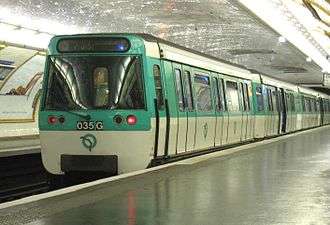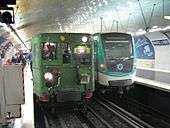MF 77
The MF 77 (abbreviated from the French: Metro Fer appel d'offre 1977) is a steel-wheeled variant of the rolling stock used on the Paris Métro. First used in 1978, it now runs on Lines 7, 8, and 13.
| MF 77 | |
|---|---|
 MF 77 on Sully Morland, Paris Métro Line 7. | |
| In service | 1978 - present |
| Manufacturer | Alstom, CEM-Oerlikon, Creusot-Loire, ANF-Industry, Jeumont-Schneider |
| Refurbished | 2007 (for Line 13), 2018 (for Lines 7 & 8) |
| Number built | 985 cars |
| Formation | 5 per trainset |
| Capacity | 574 per train set |
| Operator(s) | RATP |
| Line(s) served | |
| Specifications | |
| Car body construction | Aluminium alloy |
| Train length | 77,400 mm (253 ft 11.2 in) |
| Width | 2,450 mm (8 ft 0.46 in) |
| Maximum speed | 100 km/h (62 mph) (Design) 70 km/h (43 mph) (Service) |
| Weight | Total: 131 t (129 long tons; 144 short tons) Motor coach: 29.5 t (29.0 long tons; 32.5 short tons) Trailer: 21.5 t (21.2 long tons; 23.7 short tons) |
| Power output | 1,500 kW (2,000 hp) |
| Acceleration | 0.9 m/s2 (3.0 ft/s2) |
| Electric system(s) | 750 V DC Third rail |
| Current collection method | Contact shoe |
| Bogies | Cast steel |
| Braking system(s) | Electric braking up to 24 km/h (15 mph) railway air brake & 1 disc brake on all the axles 1 brake with shoe on the rims of the trailer wheels. |
| Track gauge | 1,435 mm (4 ft 8 1⁄2 in) standard gauge |
Unlike previous models, the MF 77 was designed for travel into the immediate suburbs of Paris, and as a result has a maximum speed of 100 km/h (62 mph) which has yet to be fully utilised. In addition, it sports a new, curved silhouette with a wider midsection. Its original exterior colours, blue and white, led passengers to refer to it as "le métro blanc," or white metro.
History
Replacing the Sprague
In the early 1970s, upon the completion of the MF 67 delivery, at the time the newest steel-wheeled trains on the Métro, many technological advances in braking and traction caused the RATP, which oversees operations of the Parisian public transport network, to examine the possibilities for new steel, rather than rubber, wheeled trains to replace the aging Sprague-Thomson fleet. Thus, the RATP commissioned a consortium of companies including Alstom, CEM, Creusot-Loire, and Jeumont Schneider, to design a new addition to the Métro's rolling stock, the MF 77.
The RATP's goal at the time of commission was for 1,000 cars, 600 of which to contain engines for 200 five-car sets. Later, the order was reduced to 187 sets for a total for 935 cars. The first trains were delivered in the summer of 1978, the first being run on 26 September of that year on Line 13, whose MF 67 trains were transferred to Line 8. A second order of ten sets was contracted on 4 February 1983, released in 1985 and 1986.
The trains on Line 13 recently underwent their mid-life refurbishment, which included a new interior configuration, updated destination signage, lighting and mechanical improvements. However, the RATP was largely dissatisfied with the refurbishment of the Line 13 trains, citing problems with the contractor that handled the work, as well as defects in the workmanship. Though it is expected that the trains on Line 8 will be refurbished next, followed by the trains on Line 7, the RATP will explore other avenues to carry out the work, even if it means that the refurbishment is done on a lesser scale (similar to that of the refurbishment of the MF 67 on Lines 10 and 12).[1]
As of January 2019, trains on the 7 & 8 are undergoing renovation, but on a lesser scale to that of trains on the 13.[2] While seating on board the trains are extremely similar, noticeable differences between the two projects include:
- Keeping the 2X2 (2 forward-facing seats per side) configuration in the middle of each car, instead of going to the 2X1 (alternating 2 forward-facing seats on one side & 1 forward facing seat on the opposing side) configuration seen on the 13. The ends of each car have been fitted with longitudinal seating as their counterparts on the 13 were.
- Retaining the ceiling lighting panels, grates, & other components as opposed to replacing them completely.
- Retaining elements such as handlebars & static strip maps. Some new handlebars were added to each car however.
- Not installing automated announcements, unlike their counterparts on the 13 that are equipped with such announcements, as well as electronic strip maps.
Additionally, renovated trains on the 7 & 8 will sport the new joint RATP/Île-de-France Mobilités (formerly known as STIF) blue/white livery.
Technical specifications
- Train-sets delivered: 197
- Configuration: M+R+M+R+M
- Overall length: 77.40 m (253 ft 11 1⁄4 in)
- Maximum width: 2.45 m (8 ft 1⁄2 in)
- Weight: 131 tonnes (129 long tons; 144 short tons) (29.5 tonnes (29.0 long tons; 32.5 short tons) for the motor coaches, 21.5 tonnes (21.2 long tons; 23.7 short tons) for the trailers)
- Material: Aluminium alloy
- Power: 1,500 kW (2,000 hp)
- Acceleration: 0.90 m/s2 (3.0 ft/s2) (in normal load)
- Braking: Electric braking up to 24 km/h (15 mph) + air-operated brake. 1 disc brake for all the axles + 1 brake with shoe at wheels on the trailers
- Bogies: Cast solid wheel
- Maximum speed: 100 km/h (62 mph)
- Authorized speed: 70 km/h (43 mph)
- Doors: 3 sliding doors per face with manual opening, opening of 1,575 mm (62.01 in)
- Air-conditioning: None
- Seats: 128 + 118 (folding seats)
- Capacity: 574 people
Gallery
 Old interior
Old interior Renovated interior (Line 13)
Renovated interior (Line 13) Renovated interior (Lines 7 and 8)
Renovated interior (Lines 7 and 8) Driver's cab
Driver's cab- Underframe of the front car of a MF 77 train, showing the autopilot equipment
Other networks
- Lisbon Metro had a forked variant called ML79
External links
| Wikimedia Commons has media related to MF 77. |
